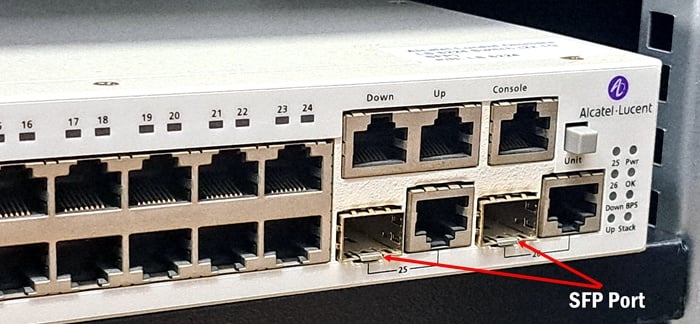Blog, Networking Device
SFP vs RJ45: How to Choose?
When building your network, are you unsure whether to choose a switch with SFP or RJ45 ports? If you haven’t purchased your switch yet, please take a moment to read this blog. This post will help you make a decision.
SFP vs RJ45: Transmission Medium and Distance
RJ45 port supports only copper cables (Cat5, Cat6) and comes with built-in fixed ports. It allows you to connect it directly using a network cable for a transmission distance of less than 100 meters. It is typically used in home networks or local area connections.
The SFP port is for an SFP transceiver, which requires multi-mode fiber (MMF) or single-mode fiber (SMF) for connection. The transmission loss of optical fiber is significantly lower than copper wires, so the SFP transceiver’s distance ranges from 100 meters to 160 kilometers. This makes SFP a better choice for long-distance applications.
Additionally, if an RJ45 connector is needed for your application, an RJ45 copper SFP can also be used, making the SFP port more flexible than RJ45.
SFP vs RJ45 Data Rate
The RJ45 port typically supports speeds of 10/100/1000 Mbps. However, some 2.5G and 10G switches also support 2.5 multigigabit RJ45 ports and 10 gigabit RJ45 ports.
SFP port supports higher speeds, such as 1G and 10G, through various modules. Fiber modules provide higher bandwidth and lower latency, making them suitable for data center core layers or cross-floor backbone connections.
So, if you have a special data rate request or you want to upgrade the network speed in the future, a switch with SFP ports would be a good choice.
SFP vs RJ45 Cost
SFP or RJ45 port switch? Cost is an essential factor to consider. In the beginning, RJ45 switches and copper cables are low-cost and easy to deploy, making them suitable for limited budgets.
However, RJ45 ports have fixed functions and limited scalability, meaning if you need to increase the data rate, you will likely need to replace the entire switch.
In contrast, SFP ports allow you to replace the module according to your needs (such as upgrading from 1G to 10G) to accommodate future network upgrades. When you update your network, you don’t need to purchase a new switch; you only need to update the SFP module. If you calculate it this way, the overall cost will be lower than buying the RJ45 port switch at the beginning.
Of course, if you already have copper cabling installed, you can use your existing infrastructure with inexpensive cabling.
What is the real power consumption: SFP vs RJ45?
Power consumption is often overlooked but is worth noting.
Power Consumption of a Single Gigabit SFP Port: Optical module (single-mode/multi-mode): Typical power consumption is 0.5-1.5W (low power models can reduce this to 0.7W).
RJ45 SFP module: Power consumption is slightly higher, generally around 1-2W.
It seems that a 1w difference is nothing, but don’t forget that each switch may have 24 or 48 ports. The power consumption needs to be calculated for both ends of the connection and all the switch ports. What will be the difference if the network runs day and night, 365 days a year? With SFP, you can mix and match (the 1000GBase-T module also has an RJ45 Port).
The electricity bill is worth calculating carefully. Compared with the cost of the switch, this is an ongoing expense.
Application
The RJ45 port switch is well-suited for short-distance scenarios, such as small and medium-sized office networks, desktop device access, and PoE power supply applications (e.g., IP cameras and wireless access points).
When stacking switches, an SFP port switch is ideal for long-distance communication (like campus network interconnections), high-density data centers, or high-bandwidth interconnections. Fiber connections are necessary for industrial environments that require resistance to electromagnetic interference.
Some guys may not be familiar with SFP transceivers and prefer RJ45 ports because RJ45 are plug-and-play. However, SFP transceivers are also plug-and-play. Many manufacturers produce compatible SFP transceivers that work effectively with major brands’ switches at very low prices, such as Cisco, HPE, Juniper, D-Link, and Arista. If you’re interested, please look at our Compatible SFP transceivers.
Conclusion
SFP or RJ45?After comparing the aspects mentioned above, along with your actual application, you should be able to choose between an SFP or RJ45 switch.
Read More:
- The 10 Best Home Network Switch for 2025
- OPTCORE 10G SFP+ & Patch Cable For Fortinet FortiSwitch FS-424E and FS-448E Switches
- Compatible SFP for HPE Aruba 1830 JL810A/JL811A/JL812A/JL813A/JL814A/JL815A Switches







